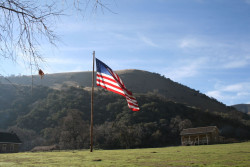Lori Wear's collections
Discovering Colonel Allensworth
<p>Born into slavery in Louisville, Kentucky in 1842, Allen Allensworth was the youngest of thirteen children of Phyllis and Levi Allensworth. While working on a farm, Allen met soldiers from the 44th Illinois Volunteer Infantry Regiment, a Union unit encamped near Louisville. When Allen told them of wanting freedom, they invited him to join the Hospital Corps. In disguise, he marched with the unit through Louisville and off to war. After serving as a civilian nursing aide for some time, in 1863 Allensworth enlisted in the US Navy, where he earned his first pay as a free man and rose from the rank of first class seaman to first class petty officer in a very short time. He was soon promoted to Captain's steward and clerk, and served on the gunboats Queen City and Tawah for two years. He was honorably discharged on April 4, 1865, after which time he worked in the commissary of the Mount City Navy Yard.</p>
<p>After the Civil War ended, Allensworth first returned to Kentucky to work and study. In 1868 he joined his brother William in St. Louis, where they operated two restaurants. Within a short time, they received a favorable offer and sold them. He worked while putting himself through the Ely Normal School, one of several new schools in the South established by the American Missionary Association. During Reconstruction, Allensworth taught at schools for freedmen and their children operated by the Freedmen's Bureau. Allensworth became involved with the Baptist Church in Louisville and attended the Fifth Street Baptist Church led by Henry Adams. He was ordained in 1871 by the Baptists as a preacher. In the 1870s, Allensworth went to Tennessee to study theology.</p>
<p>In 1877 he married Josephine Leavell (1855–1938), also born in Kentucky; they had met while studying at Roger Williams University in Nashville, Tennessee. She was an accomplished pianist, organist and music teacher. They had two daughters together, Eva and Nella. </p>
<p>With his leadership positions and public speaking, Allensworth became increasingly interested in politics. In 1880 and 1884, he was selected as Kentucky's only black delegate to the Republican National Conventions.</p>
<p>In 1886, when he was 44, Allensworth gained support by both southern and northern politicians for appointment as a chaplain in the US Army; his appointment was confirmed by the Senate, as necessary at the time, and approved by the president. He was one of the few black chaplains in the US Army and was assigned to the 24th Infantry Regiment, known as the Buffalo Soldiers. His family accompanied him on assignments in the West, ranging from Fort Bayard, New Mexico Territory to Fort Supply, Indian Territory, and Fort Harrison, near Helena, Montana. His wife played organ in the fort chapels. By the time of his retirement in 1906, Allensworth had been promoted to the rank of lieutenant colonel, the first African American to gain that rank.</p>
<p>After the army, Allensworth and his family settled in Los Angeles. He was inspired by the idea of establishing a self-sufficient, all-black California community where African Americans could live free of the racial discrimination that pervaded post-Reconstruction America. His dream was to build a community where black people might live and create "sentiment favorable to intellectual and industrial liberty." </p>
 Lori Wear
Lori Wear
21
Fort Tejon
<p>The Native Americans who lived in this area prior to the establishment of Fort Tejon are generally referred to as the Emigdiano. They were an inland group of the Chumash people. Unlike their coastal relatives, however, the Emigdiano avoided contact with European explorers and settlers, and were never brought into one of the missions or even incorporated into the Sebastian Indian Reservation. Once Fort Tejon was established, the Emigdiano often worked as independent contractors for the army, providing guides for bear hunts and delivering fresh fruits from their fields for sale in officers row. <br></p>
<p>In 1852, President Millard Fillmore appointed Edward F. Beale to the position of Superintendent of Indian Affairs for California and Nevada, and sent him to California to head off further confrontation between the Indians and the many gold seekers and other settlers who were pouring into California. After studying the situation, Beale decided that the best approach was to set up a large Indian reservation at the southern end of the San Joaquin Valley and to invite displaced Indian groups to settle there. </p>
<p>In order to implement his plan, Beale requested a federal appropriation of $500,000 and military support for the 75,000 acre reservation he had selected at the foot of Tejon Pass. Colonel Ethan Allen Hitchcock, commander of the Pacific Division of the U.S. Army, supported Beale's plan and agreed to set up a military post on or near the Indian reservation. The army was eager, in any case, to abandon Fort Miller (near Fresno, California) in favor of a more strategically advantageous site in California's southern San Joaquin Valley. </p>
<p>In August 1854, Major J.L. Donaldson, a quartermaster officer, chose the present site in Canada de las Uvas. The site was handsome and promised adequate wood and water. It was just 17 miles southwest of the Sebastian Indian Reservation, and it was right on what Major Donaldson was convinced would become the main route between the Central Valley and Southern California. </p>
<p>For almost ten years, Fort Tejon was the center of activity in the region between Stockton and Los Angeles. The soldiers, known as Dragoons, garrisoned at Fort Tejon patrolled most of central and southern California and sometimes as far as Utah. Dragoons from Fort Tejon provided protection and policed the settlers, travelers and Indians in the region. People from all over the area looked to Fort Tejon for employment, safety, social activities and the latest news from back east. </p><p>Fort Tejon State Historic Park was established in 1940 as one of the California State Parks.</p>
<p></p>
 Lori Wear
Lori Wear
69




